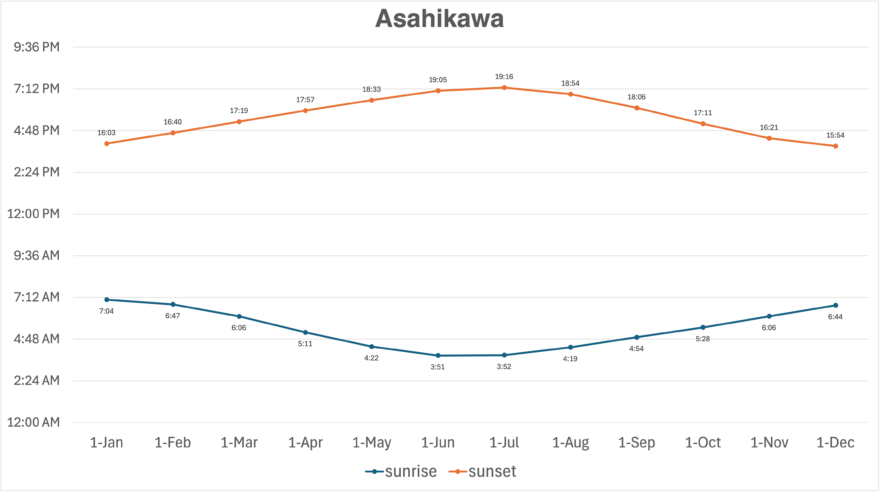Population 317,971 [June, 2024]
Asahikawa is located in north-central Hokkaido, about 1.5 hours by rapid train and 2 hours by car from Sapporo. It is the second-largest city in Hokkaido and has flourished as the biggest city in the north. Surrounded by mountains and featuring about 130 rivers, Asahikawa experiences hot summers and freezing winters, with few windy days and no rainy season. Summers are comfortable with dry weather, but in winter, temperatures can drop below -10 degrees Celsius.
Sunrise and Sunset
Here is a graph showing sunrise and sunset times in Asahikawa. Use this as a reference when taking photos of sunrises or sunsets. Don’t miss the perfect shot!
Climate
The warmest month in Asahikawa is August, with an average temperature of 21.2 degrees Celsius. The coldest month is January, with an average temperature of -7.0 degrees Celsius, indicating a large temperature difference and distinct seasonal changes. Additionally, Asahikawa, being in a basin-like area, is characterized by significant temperature fluctuations within a single day.
Spring
The cherry blossoms in Asahikawa bloom about a week later than in Sapporo. This trend is similar across Hokkaido, with various flowers blooming all at once in spring. Although spring days can be warm, mornings and evenings are often cold, so a warm jacket is necessary.
Summer
Temperatures rise rapidly from around June. Recently, even in northern Hokkaido, it’s not uncommon for temperatures to approach 30 degrees Celsius in June. However, like in spring, mornings and evenings can be chilly, so a warm outer layer is needed. Asahikawa’s midsummer is hotter than Sapporo’s. Asahikawa is characterized by cold winters and hot summers, so don’t underestimate it just because it’s further north than Sapporo. From late June, popular mountains like Asahidake and Kurodake enter the hiking season, leading into autumn. If the weather is clear, the views are stunning, so be sure to give it a try.
Autumn
Autumn foliage in Hokkaido starts in the Daisetsuzan mountains. As the highest mountain range in Hokkaido, it gets cold quickly, so the leaves change color early. By late August, hints of autumn appear, and the leaves start changing from the peaks of Asahidake and Kurodake. While summer hiking is great, the mountains during the autumn foliage season are exceptionally beautiful.
Winter
Asahikawa also hosts a snow festival, similar to Sapporo. Large snow sculptures are built in the plaza along the Ishikari River in the city. While it may not have the same glamour as Sapporo, you can enjoy impressive snow sculptures. Additionally, at Sounkyo, the annual Ice Waterfall Festival features illuminated ice sculptures created naturally from the clear stream of the Ishikari River. There are also many ski resorts, so you can fully enjoy winter activities.


